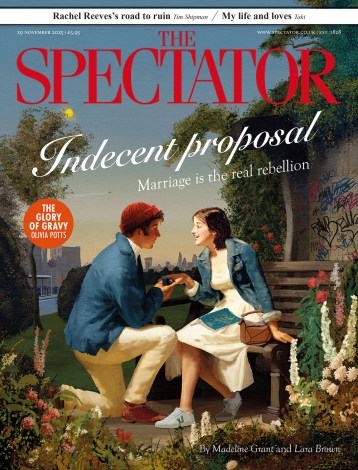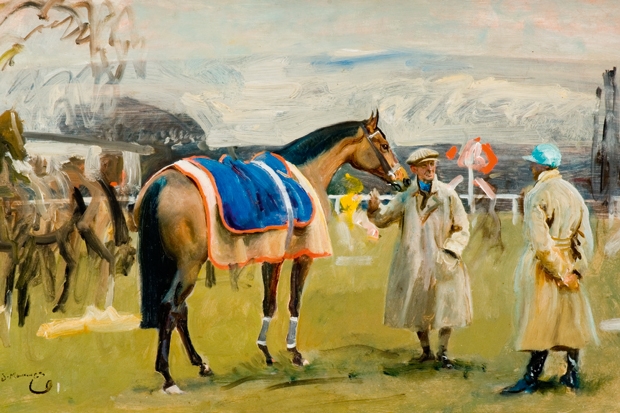Sir Alfred Munnings (1878–1959) did himself a grave and lasting disservice when he publicly attacked modern art in a bibulous after-dinner speech at the Royal Academy in 1949. He had been president of the RA for five years, pipping Augustus John to the post, but the controversy he stirred up (he called Picasso and Matisse ‘foolish daubers’) led to his resignation. The echoes of his rant linger on more than half-a-century later, constituting for many the most memorable thing about him. Like Canute, Munnings could not stem the tide, and Modernism for a time swamped and eroded his reputation. Now, as people begin to look at his work again, his real genius as a painter in a post-Impressionist mode — but ineradicably of the British Romantic tradition — is re-emerging.
One of the things that has served to redirect the spotlight on to him is an enjoyable new film called Summer in February, based on the excellent novel of that name by Jonathan Smith. This focuses on the period just before the first world war when Munnings lived in Cornwall and was part of the Newlyn School, painting with such talented friends and colleagues as Laura Knight and Lamorna Birch.
The film is as much a complicated love story as it is the portrait of a young artist, and recounts Munnings’s first, and tragically short-lived, marriage. In 1912, he married Florence Carter-Wood, who killed herself two years later. Munnings never referred to this episode, and Florence is not mentioned in any of his three volumes of autobiography. He married again in 1920, choosing this time Violet McBride, the daughter of a London riding master and herself an exceptional horsewoman, and they settled at Castle House in Essex.
Castle House is an elegant property of Tudor origins remodelled in the Georgian period, situated on the outskirts of Dedham in Constable Country, on the borders of Essex and Suffolk. It is surrounded by 70 acres of land, and admirers of Munnings the horse painter (to many, he is the greatest of 20th-century equestrian artists) will be glad to hear that there are a couple of horses back in the paddock adjoining his studio. The house was his home for 40 years and is now a museum dedicated to his work. Beautifully proportioned and filled with light, its well-appointed public rooms have a remarkably welcoming and friendly atmosphere for such a controversial artist. His paintings are everywhere, and it is possible to examine his canvases at close quarters with searching intimacy, for none is behind glass. Even the most expensive near-invisible ‘museum glass’ doesn’t give you such a direct relationship with a picture. For this luxury alone the museum is worth a visit, but there are many other things to recommend it.
This year the displays of Munnings’s work have been re-organised into a focus on the Cornwall Years, to coincide with Summer in February. The large painting ‘Two Lady Riders under an Evening Sky’ (1910-15) is thought to depict Florence and thus has an added piquancy beside its painterly zest. Also in the downstairs library is a group of five paintings of blossom in springtime Cornwall, recently conserved and on show together possibly for the first time. In the dining room are some excellent horse and rider paintings, including the dynamic ‘Phyllis and Rachel (The Two Dianas)’, and in the drawing room the superb early oil ‘Path to the Orchard’ (1908), composed of lush and vibrant paint-strokes.
Upstairs there are displays dedicated to Munnings’s landscapes and drawings, intended to show people that he didn’t just paint horses. Although best-known for his swagger portraits and sporting pictures, he was a rumbustious yet lyrical landscapist, and painted Exmoor (where Munnings and his wife relocated in 1939 when Castle House was requisitioned by the army), with great dash and affection, in summer or under snow. Here too is ‘A View of Dedham Vale with Stacks in Fields’, with the wind rousing the willows evocatively, and ‘Pastoral Scene with Trees and a Stream in the Foreground’, with much more texture scratched into it, and wriggles of bright red and blue. In the room given over to drawings, there are tree and landscape studies, a beautiful hunting scene in charcoal (entitled ‘Taking a Ditch’), and a wall of people. Some of these are a bit too illustrational, though not without narrative verve, but ‘The Gardener’s Daughter’ is a fine detailed head of a girl with contrastingly loosely handled dress.
Dominating the staircase is a big painting of Lady Violet Munnings riding a grey hunter, superbly assured against a finely painted sky and moorland setting. Lady Violet’s Pekingese, Black Knight, who was made a Freeman of the City of London (such are the benefits of dining with the influential), wrote a memoir that he called Diary of a Freeman. Actually I think he dictated it to Lady Violet, who was his devoted slave in all things. After he died she had him stuffed, and continued to carry him to the village on errands. He now reposes on a favourite cushion in a glass case beneath Munnings’s portrait of him, in a cubby hole off the main staircase. He remains extremely popular with regular visitors.
The museum is open five afternoons a week (up from four last year), Wednesday to Sunday, 1 April to 31 October. There are plans to make it more accessible during the off-season, and indeed many schemes are afoot to improve the amenities and capitalise on its unique resources. The museum has recently appointed its first director, Jenny Hand, and in James Johnston, the new chairman of the Castle House Trust, it has found an energetic and enthusiastic promoter.
Paintings are regularly loaned to other museums, and this spring and summer a number of pictures have been out at Penlee House Gallery in Penzance for an exhibition devoted to Art in Lamorna 1910–14, cashing in on the new film. At the same time, seven other Munnings paintings have been on loan to America, to the National Sporting Library and Museum in Virginia, which has been staging Munnings: Out in the Open, an exhibition focusing on his plein-air painting. This seems to have been very favourably received — the Americans have long enjoyed and appreciated his work, contributing substantially to his healthy auction prices, and it is there that a catalogue raisonné is being attempted (huge task). Undoubtedly more scholarship and research on Munnings needs to be conducted in this country, and the Munnings Collection at Castle House is exceedingly well placed to lead and co-ordinate it. With a major painting included in the current Tate rehang (‘Their Majesties’ Return from Ascot’, 1925, featuring King George V and Queen Mary in an open carriage), it seems that Munnings is being taken seriously as an artist again: about time, too.






Comments